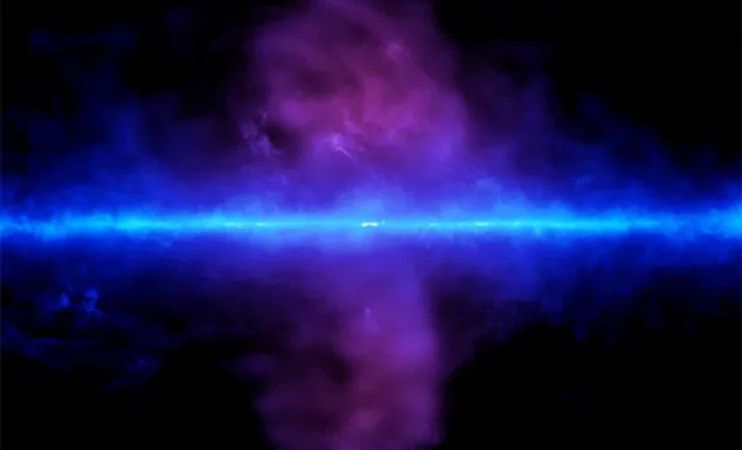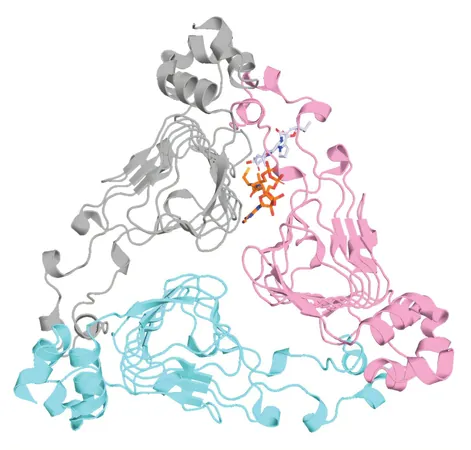
Mind-Blowing Discovery: Ice Cube Clouds in the Milky Way Hint at a Recent Black Hole Explosion!
2025-07-19
Author: Sarah
A Shocking Revelation from the Heart of Our Galaxy
In an astonishing twist of cosmic fate, scientists have unveiled an incredible anomaly in the depths of the Milky Way. Nestled within the enigmatic Fermi bubbles—mighty regions of superheated plasma—researchers have discovered cold hydrogen clouds that boggle the mind. These icy giants, sprawling over distances larger than our entire solar system, should have never survived in such ferocious conditions!
What Are the Fermi Bubbles?
First spotted in 2010 by NASA’s Fermi Gamma-ray Space Telescope, the Fermi bubbles are titanic structures soaring 25,000 light-years above and below our galaxy's core. Invisible to the naked eye, these colossal formations stretch a staggering 50,000 light-years and boast mind-numbing temperatures exceeding a million kelvins—a mere whisper away from 2 million degrees Fahrenheit! Scientists theorize that they originate from violent explosions unleashed by a supermassive black hole at the galaxy's heart.
Ice Cube Clouds: Nature’s Improbable Survivors!
But here comes the kicker! Amidst this storm of swirling plasma, researchers have found giant clouds of cold hydrogen gas, ranging from 13 to 91 light-years across. Their presence within an environment that should have obliterated them long ago turns science on its head. According to Rongmon Bordoloi, the leading investigator from North Carolina State University, these clouds might be echoes of much larger structures once ejected from the galactic core.
Bordoloi cleverly compares their survival to tossing an ice cube into boiling water: while the small cube sizzles away quickly, a larger one resists the heat far longer. This possibility suggests that these clouds were once much grander but have been slowly eroded by the relentless cosmic winds.
Timing the Black Hole's Fury
This thrilling discovery offers a groundbreaking way to ‘date’ the last major eruption of the Milky Way's central black hole. The long-sustaining cold hydrogen clouds hint that this disturbance occurred only a few million years ago, a mere blink in cosmic time.
This finding significantly narrows down the age of the Fermi bubbles and reshapes our understanding of the violent and periodic outbursts linked with our galaxy's supermassive black hole. The implication? These explosive outbursts could be far more frequent than astronomers ever thought, shedding light on the frenzied activity of the cosmos right in our backyard!
Stay Tuned for More Cosmic Wonders!
As scientists continue to unravel the mysteries of our universe, keep an eye out for more riveting stories that push the boundaries of our understanding. Don't miss out—subscribe to our newsletter for the latest discoveries and exclusive content!



 Brasil (PT)
Brasil (PT)
 Canada (EN)
Canada (EN)
 Chile (ES)
Chile (ES)
 Česko (CS)
Česko (CS)
 대한민국 (KO)
대한민국 (KO)
 España (ES)
España (ES)
 France (FR)
France (FR)
 Hong Kong (EN)
Hong Kong (EN)
 Italia (IT)
Italia (IT)
 日本 (JA)
日本 (JA)
 Magyarország (HU)
Magyarország (HU)
 Norge (NO)
Norge (NO)
 Polska (PL)
Polska (PL)
 Schweiz (DE)
Schweiz (DE)
 Singapore (EN)
Singapore (EN)
 Sverige (SV)
Sverige (SV)
 Suomi (FI)
Suomi (FI)
 Türkiye (TR)
Türkiye (TR)
 الإمارات العربية المتحدة (AR)
الإمارات العربية المتحدة (AR)